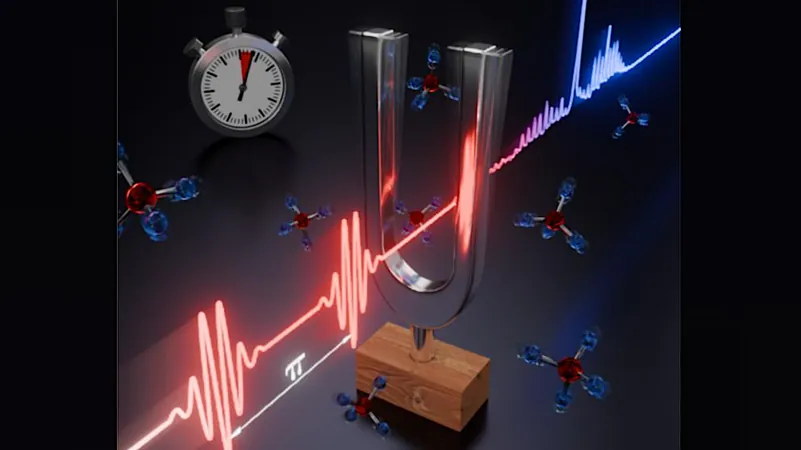
Breakthrough in Fast Gas Detection Could Revolutionize Environmental Monitoring and Healthcare!
2025-01-10
Author: Siti
Introduction
Exploring distant worlds comes with its challenges, particularly when it comes to analyzing gases that create a picture of their environment. The recent advancements in gas detection technology could significantly simplify this process, leading to profound implications for both astrobiology and efficient monitoring of our own planet's atmosphere.
New Method Unveiled
Researchers from the University of Stuttgart have unveiled a state-of-the-art method called coherently controlled quartz-enhanced photoacoustic spectroscopy (QEPAS). This cutting-edge technique allows for the rapid detection of very low concentrations of gases, paving the way for transformative applications in sectors like environmental monitoring, healthcare, and industrial safety.
Expert Insight
“The ability to detect trace amounts of gases quickly is critical across numerous industries,” stated Simon Angstenberger, team leader of the research initiative. Unlike traditional methods, this innovative approach does not require prior knowledge of the specific gas being detected, giving it a significant edge.
Breakthrough Performance
Recently detailed in the journal Optica, the researchers demonstrated their method's capability of capturing a complete methane spectrum in a mere three seconds—an impressive improvement over the typical 30-minute benchmarks associated with conventional techniques. This improvement highlights not only the speed but the efficiency of the spectroscopy, which could be indispensable for climate monitoring efforts aimed at assessed climate change's key players like methane emissions.
Broader Implications
Angstenberger emphasizes the broader impact, "This technology could drastically change how we detect greenhouse gases, potentially providing vital data for climate monitoring. Additionally, it has significant implications for early cancer detection through breath analysis and could play a crucial role in chemical production facilities by identifying hazardous gas leaks promptly."
Detection Mechanism
The heart of this technology lies in its advanced detection mechanism, which operates by analyzing the unique light absorption characteristics of gases. By employing a rapidly tunable laser in conjunction with a sensitive quartz tuning fork, the researchers achieved real-time monitoring of gas concentrations. The laser pulses rapidly heat the gas, distinguishing its “fingerprint” and assisting in identifying various trace gases without the limitations of traditional setups.
Innovative Approach
To enhance the detection process, the researchers introduced a method termed “coherent control.” This innovative approach synchronizes the timing of the laser pulses to optimize the gas's response, effectively ceasing the tuning fork's movement to ensure clear readings. This breakthrough allows for an impressive tuning range of 1.3 to 18 micrometers, enabling the identification of a wide spectrum of trace gases.
Future Directions
The team's next steps involve further refining their technology to ascertain its performance limits, including its maximum speed and lowest detection thresholds. Excitingly, they also plan to explore its capabilities in detecting multiple gases simultaneously, expanding its practical applications.
Conclusion
This revolutionary technology could soon usher in a new era of efficient gas monitoring and analysis, not only enhancing our understanding of environmental conditions but also potentially saving lives through improved healthcare protocols. The future of gas detection is bright, and it's only just beginning! Stay tuned as these promising researchers continue to push the boundaries of what we understand about our atmosphere, the environment, and beyond!

 Brasil (PT)
Brasil (PT)
 Canada (EN)
Canada (EN)
 Chile (ES)
Chile (ES)
 Česko (CS)
Česko (CS)
 대한민국 (KO)
대한민국 (KO)
 España (ES)
España (ES)
 France (FR)
France (FR)
 Hong Kong (EN)
Hong Kong (EN)
 Italia (IT)
Italia (IT)
 日本 (JA)
日本 (JA)
 Magyarország (HU)
Magyarország (HU)
 Norge (NO)
Norge (NO)
 Polska (PL)
Polska (PL)
 Schweiz (DE)
Schweiz (DE)
 Singapore (EN)
Singapore (EN)
 Sverige (SV)
Sverige (SV)
 Suomi (FI)
Suomi (FI)
 Türkiye (TR)
Türkiye (TR)
 الإمارات العربية المتحدة (AR)
الإمارات العربية المتحدة (AR)